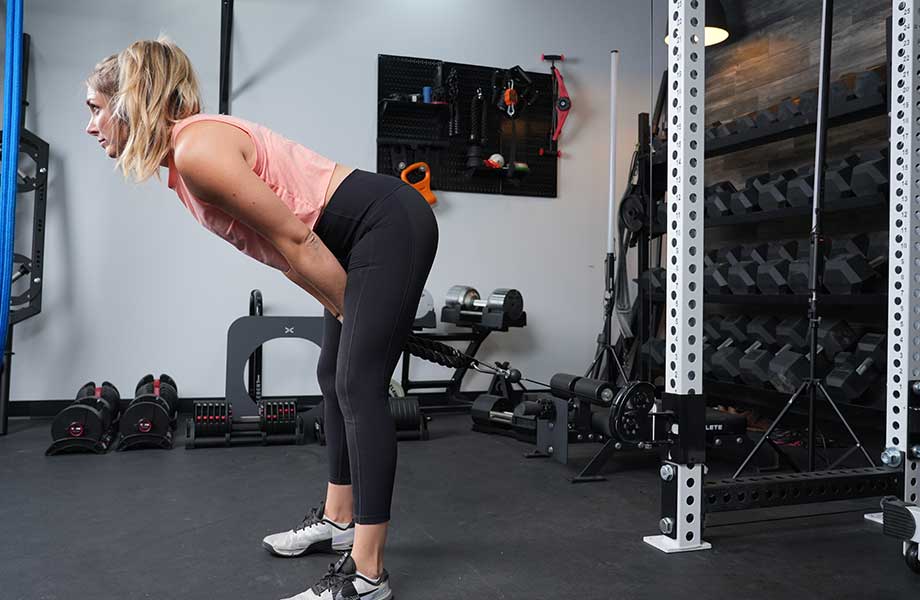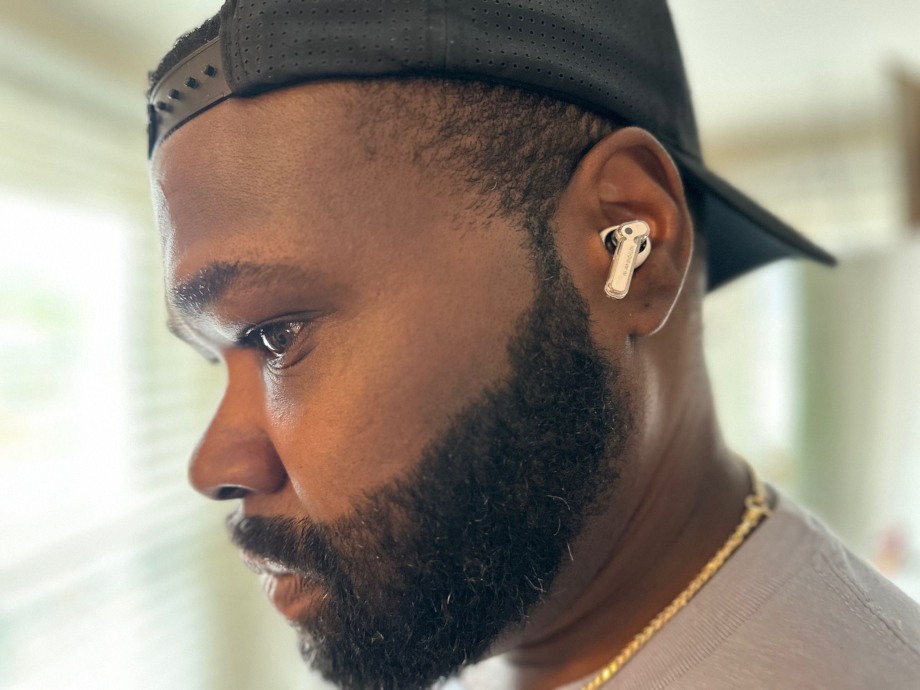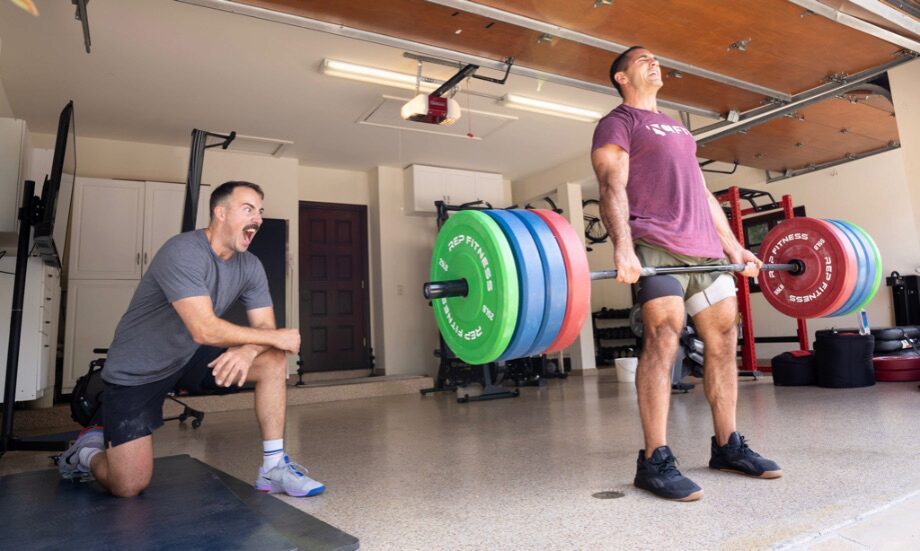To get bigger, stronger legs, free weight exercises are what’s usually talked about in the fitness world. There’s nothing wrong with these exercises. In fact, as a certified personal trainer, I’m a huge fan. But there are also downsides. Barbell, kettlebell, or dumbbell leg workouts can take up a lot of time. And if you’re new to training or have injuries, it can be difficult to get your form right. Isolating those smaller muscle groups doesn’t come as easy, either.
Don’t worry because I’m here with an alternative. You guessed it, cable leg workouts.
Cable machine workouts have tons of benefits for your leg training, which you’ll see below. I’ll also explain, step-by-step, how to do the nine best cable leg exercises, before providing you three cable leg workouts to add to your next leg day session.
You might be ready to get started straight away or need more convincing. That’s where I and Kate Meier, CPT, USAW-L1, CF-L1, and GGR Head of Content, come in. Let’s get straight into the benefits of cable leg workouts.
Why Use a Cable Machine for Legs?
Before we crack into our cable leg workouts, here are three benefits of using a cable machine to train your legs:
Safety
Getting the correct form on exercises, such as barbell squats and deadlifts, can be difficult, especially if you’re new to strength training. Even if you’re not, there’s still a risk of injury. Free weights can also put stress on the knee and ankle joints. “The cables, although they don’t completely stop the risk of getting injured, they do definitely minimize it,” Kate Meier, CPT, USAW-L1, CF-L1, says.
RELATED: Best Cable Machine for Your Home Gym
Range of motion
Compared to free weights, you’re able to get an increased range of motion using the cable machine. For the legs (and any other muscle group you decide to do on the cables), this means the most possible work for every rep. If you have an injury that limits your range of motion, no problem. Cables can adapt to your mobility.
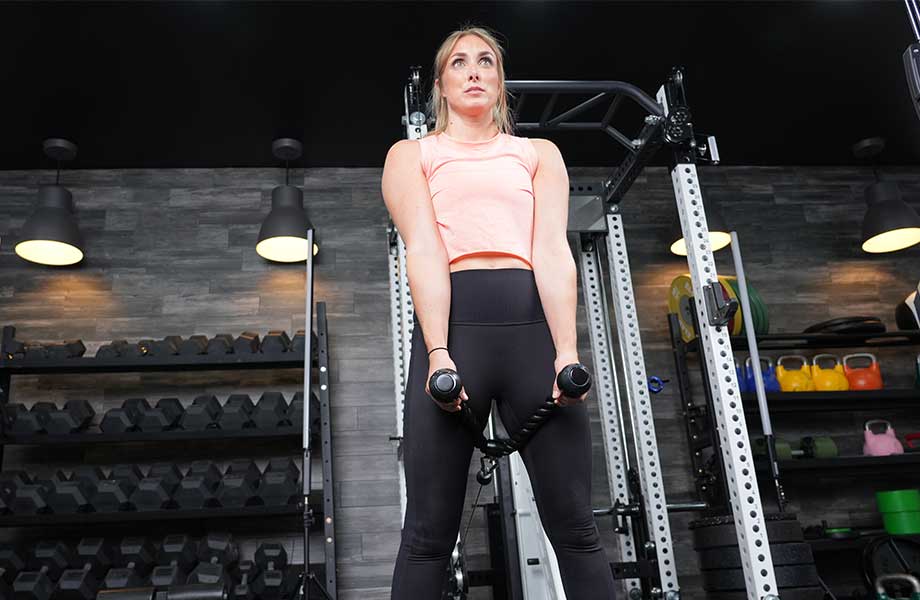
Efficiency
If you’re limited on time, using a cable machine to train the legs can be a good idea. It takes a second to change the weight, rather than loading and unloading weight plates on a bar. It’s likely your rest times between sets will be shorter, too. You can also do superset workouts to shave off even more gym time. Usually, 20 to 30 minutes is all you’ll need with a cable leg workout.
Leg Anatomy
Let’s talk about leg anatomy. These are the muscle groups that make up the lower body and their functions:
Quads
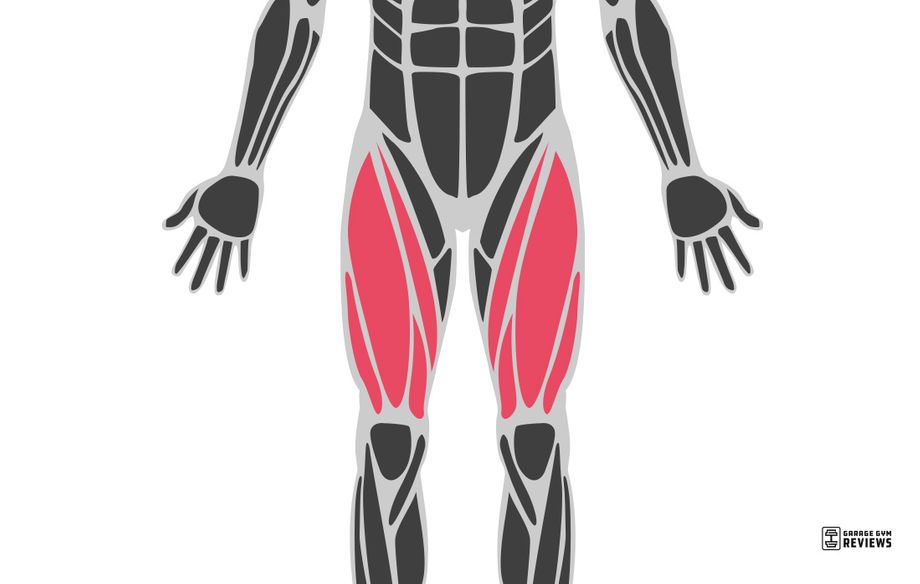
The quadriceps are made up of four muscles:
- Vastus lateralis
- Vastus intermedius
- Vastus medialis
- Rectus femoris
In terms of function, all four are responsible for extending the knee1, but the rectus femoris is also an accessory flexor of the hip1. The quads are found at the front of the thigh.
Hamstrings
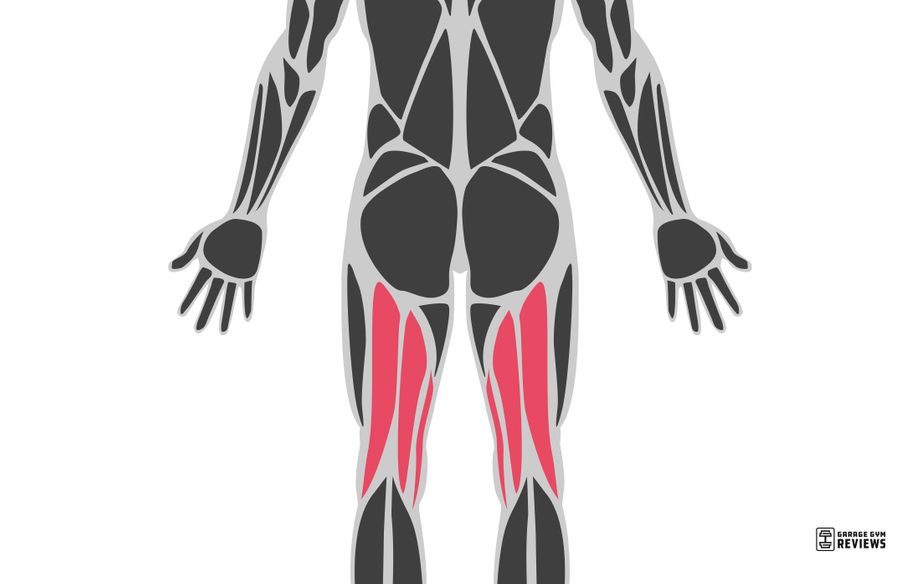
The hamstrings, located at the back of the thighs, play a critical role in human activities ranging from standing to explosive actions such as sprinting and jumping2. They’re responsible for hip extension and knee flexion, and the three muscles that make up the hamstrings are:
- Biceps femoris (long and short head)
- Semitendinosus
- Semimembranosus
Glutes
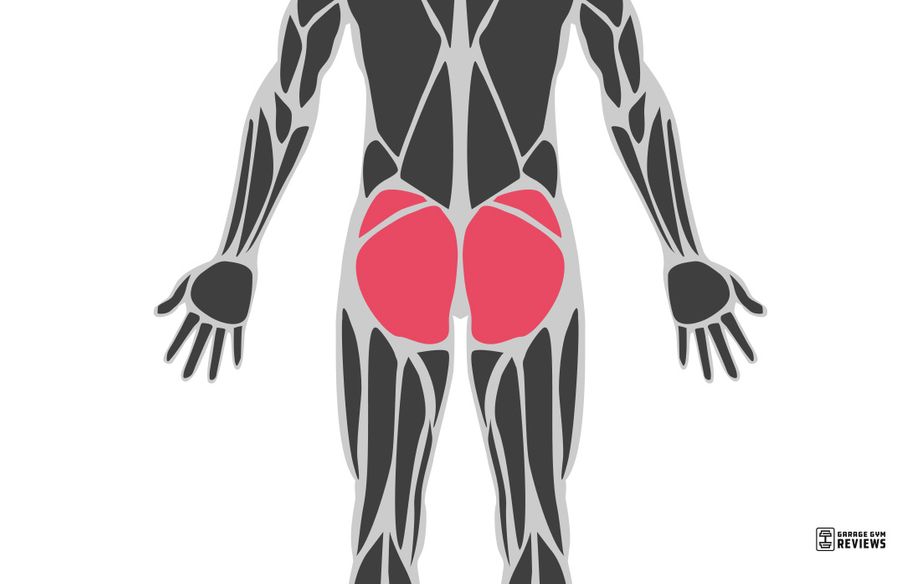
The glutes are found at the back of the pelvis, and the main muscles are:
- Gluteus maximus
- Gluteus medius
- Gluteus minimus
The largest muscle (gluteus maximus) acts as the chief antigravity muscle during sitting by counteracting and controlling the flexion of the hip3. Collectively, the main actions of the glutes are to extend and externally rotate the thigh.
Calves
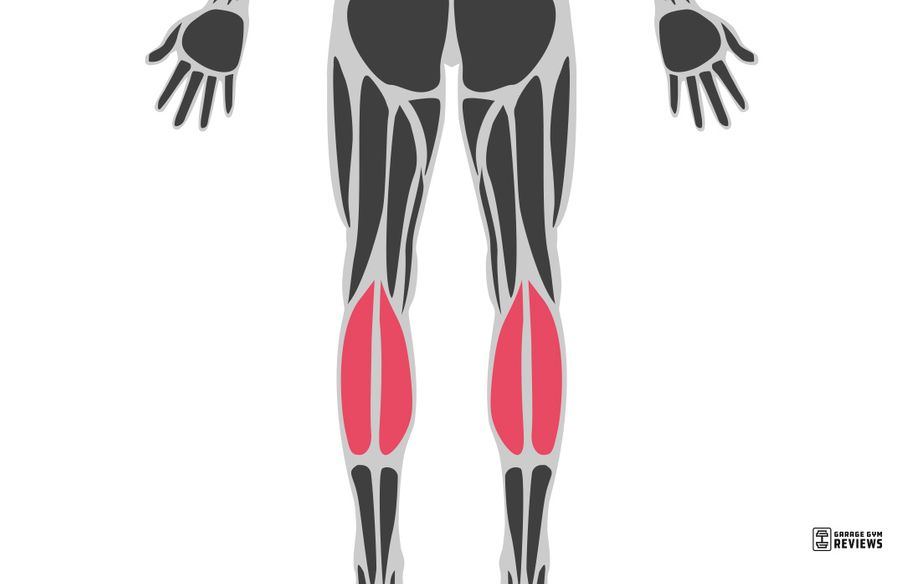
The calves muscle group has two muscles:
- Gastrocnemius
- Soleus
The calves are responsible for plantarflexion of the foot and ankle4, and the calf muscles are used in activities such as running and jumping.
Cable Leg Exercises
Now that you know the benefits of using a cable machine for the legs, as well as each muscle that makes up the lower body, here are the nine best cable leg exercises for you to try:
Cable Goblet Squat
Why we love it: Leg day isn’t complete without squats! The goblet squat is usually done with a dumbbell or kettlebell, but the cable version is just as effective in building muscle in the quadriceps, hamstrings, and glutes. They’re also a lot safer to do on the cables.
How to do it:
- Set the pulley to the bottom position, and attach a rope or a v-bar attachment.
- Facing the cable machine, take hold of the attachment using a neutral or underhand grip. Place it in front of your chest.
- Take a couple of steps back to create tension. Adjust your feet so that they’re slightly wider than shoulder-width apart, and brace your core.
- Squat down until your quads are at least parallel to the ground. Pause.
- Drive through your heels to return to the standing position.
- Continue for the desired number of repetitions.
RELATED: Kettlebell Squats
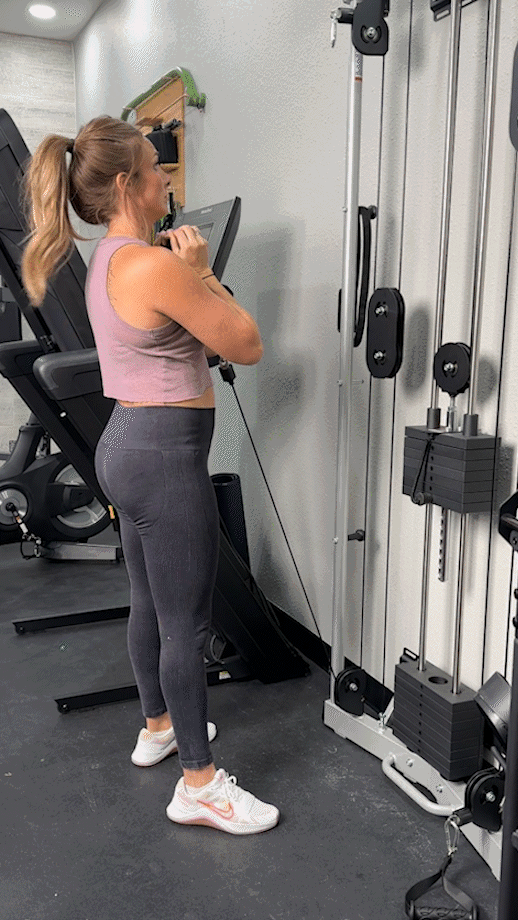
Cable Pull-Through
Why we love it: Kate Meier, CPT, USAW-L1, CF-L1, says, “Cable pull-throughs are an effective exercise to work the hamstrings and glutes at the back of the legs.” Regularly doing them can improve your barbell lifts, such as squats, deadlifts, Romanian deadlifts, and even hip thrusters.
RELATED: Hip Thrust Workout
How to do it:
- Attach a rope handle to a pulley, then position it at the bottom. Select the desired weight.
- Grab the rope between your legs while you’re standing facing away from the cables. Take a step or two forward.
- Tense your core and keep your head neutral. Begin the movement by bending at the hips, letting the rope move closer to the cable machine. You’ll feel a stretch in the hamstrings here.
- Hold when you can’t lower further, then push through the glutes to return to the starting position.
- Keep pulling through for reps.
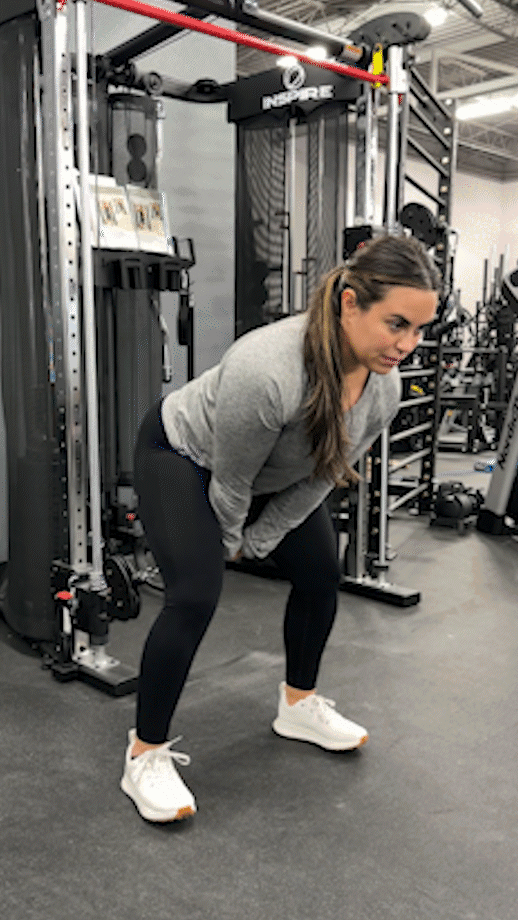
Cable Kickback
Why we love it: You’re working one side at a time (or unilateral exercises), so glute kickbacks help fix muscular imbalances on either side of the body. They isolate the glutes, and strengthening them may lead to increased spinal stability and less pain5 in the lower back.
How to do it:
- With the pulley in its lowest position, add an ankle strap attachment. Loop it around your left ankle, then stand up tall.
- Hold the cable machine with both hands to keep you stable, and adjust your feet so they’re shoulder-width apart.
- Lift your left leg backward and toward the ceiling. Your right foot should be firmly planted on the ground, with a slight bend in your right knee.
- Hold at the top, then lower your left leg to the ground.
- Kick back for reps, then switch over to the right leg.
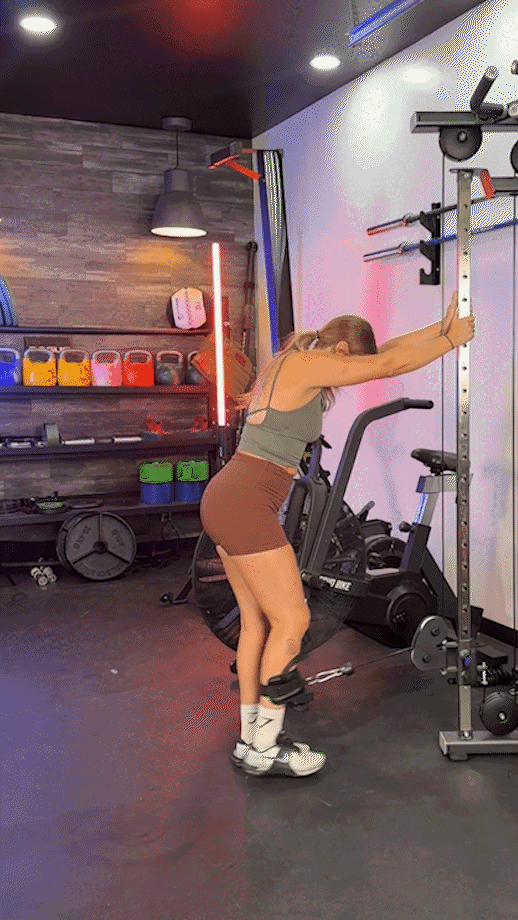
Cable Deadlift
Why we love it: “If you’re new to lifting or have past injuries, getting the right form on the barbell deadlift can be difficult to master,” explains Kate. “This is where the cable deadlift comes in, and you still activate all of the muscles on the backside of your body.”
How to do it:
- Adjust the cable pulley to the lowest setting, then attach a long, straight-bar attachment.
- Take hold of the bar with an overhand grip. You’ll want to face the cable machine, and both your hands and feet should be hip-width apart.
- Hinge at your hips to begin the deadlift, keeping your back straight throughout. The bar attachment will move toward the pivot point of the cables.
- When you can’t go any further, hold, then push through your feet to return to the upright position. Squeeze your glutes here.
- Continue for the desired number of reps.
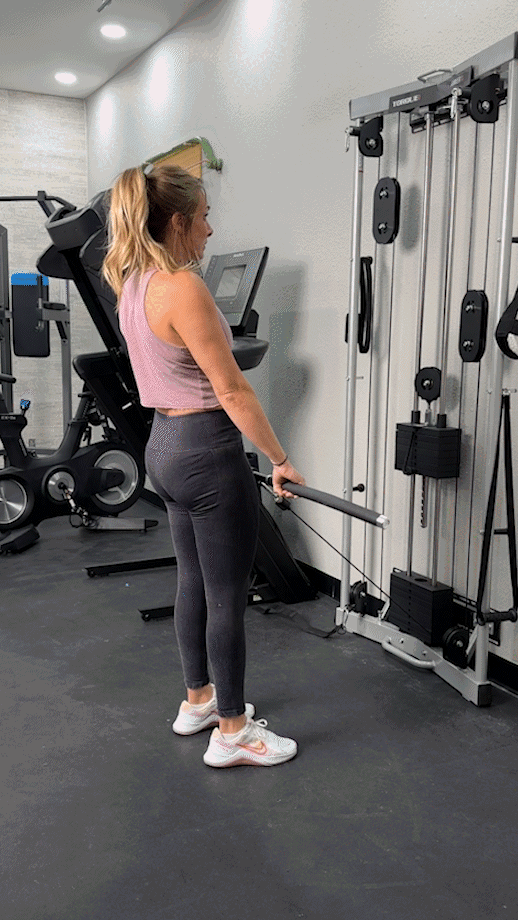
Cable Hip Adduction
Why we love it: Working smaller muscle groups in the lower body, such as the adductors, can help to prevent groin injuries6. You use your inner thighs during squats and deadlifts (and during most lower-body workouts). Doing this exercise may also help improve your flexibility.
How to do it:
- Loop an ankle cuff around your left ankle, and fix the pulley to the bottom.
- Stand up tall and grab the cable machine with your right hand, facing away from it.
- Lift your left leg out to the side. Then, adduct it by moving your left foot toward your right foot (just in front of it). Slowly reverse the motion.
- Repeat for reps, then switch over to the opposite side.
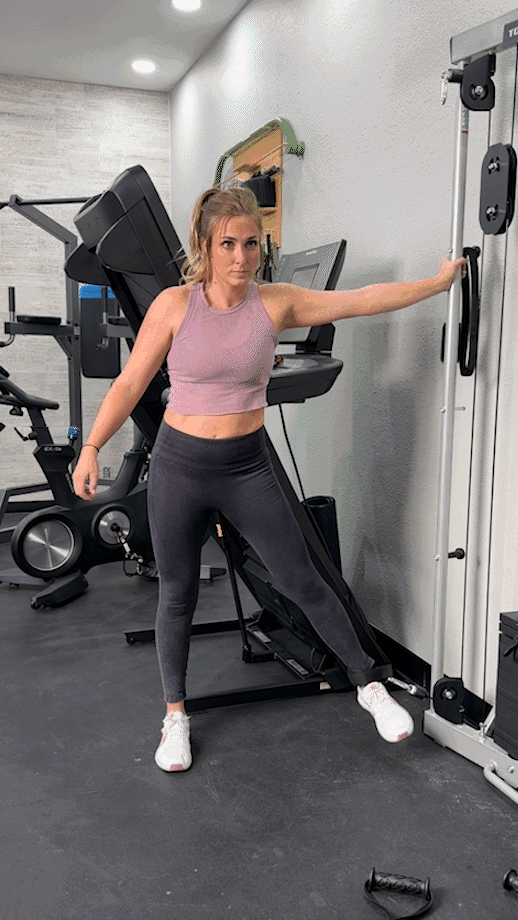
Cable Hip Abduction
Why we love it: The abductors are the opposite of the adductors, and make up your outer thigh. The cable hip abduction is a popular cable machine exercise, and strengthening the abductors is a rehabilitative treatment for subjects with knee osteoarthritis7.
How to do it:
- Attach an ankle strap to your left ankle while the cable pulley is at the bottom.
- Take hold of the machine with your right hand, and face away from it.
- Position your left foot in front of your right foot. Perform the abduction motion by moving your left foot out to the side. Pause for a second, then bring it back to the starting position.
- When you’ve finished your reps, switch over to the right ankle and repeat.
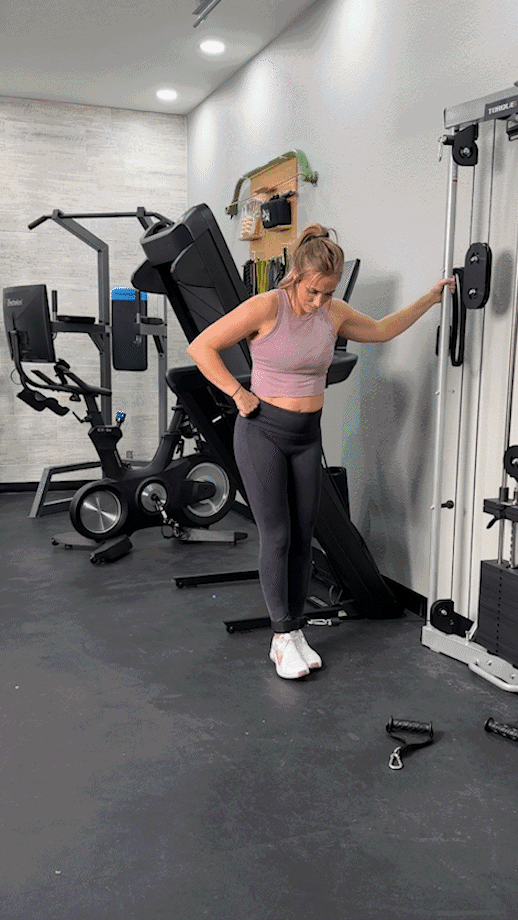
Cable Standing Leg Curl
Why we love it: ”It’s a great cable machine leg exercise because it isolates your hamstrings,“ says Kate. For those who have desk jobs, tight or weak hamstrings can be a real pain point. This exercise can strengthen that particular muscle group and help with flexibility, too.
How to do it:
- Select your desired weight, then fasten an ankle strap around your left ankle. You’ll want the pulley to be at the lowest position.
- Face the weight stack, and grab the machine with both hands for stability.
- Move your feet so they’re close together. While shifting some of your weight onto your right leg, curl your left foot toward your butt until it’s at a 90-degree angle.
- Slowly lower your left foot to the floor.
- Curl for repetitions, then switch over to the right side.
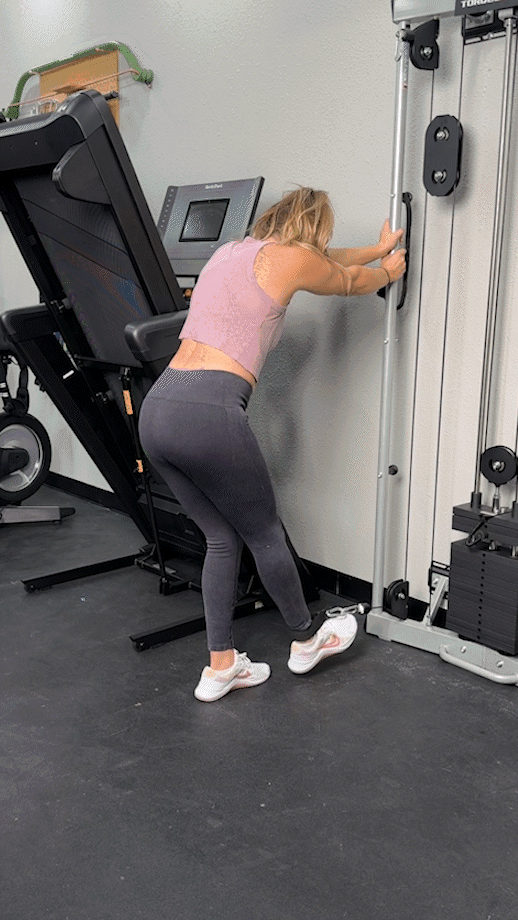
Cable Front Lunge
Why we love it: Although we’re calling out the front lunge here, you can also do lateral or reverse lunges on the cables, making this an extremely versatile exercise. The lunges exercise is a popular bodybuilding movement, and doing them on the cables may help reduce the risk of injury.
How to do it:
- With the pulley at the bottom, add a rope attachment to it.
- Face standing away from the machine, and take hold of the rope. You’ll want your feet shoulder-width apart, and the rope positioned on either side of your shoulders.
- Brace your core and keep your head neutral, then lunge forward with your left foot. Lower your right knee towards the floor.
- Hold, then drive through your left heel to return to the upright position.
- Repeat, but this time, lunge forward with your right foot first.
- Lunge for reps, alternating sides each time.
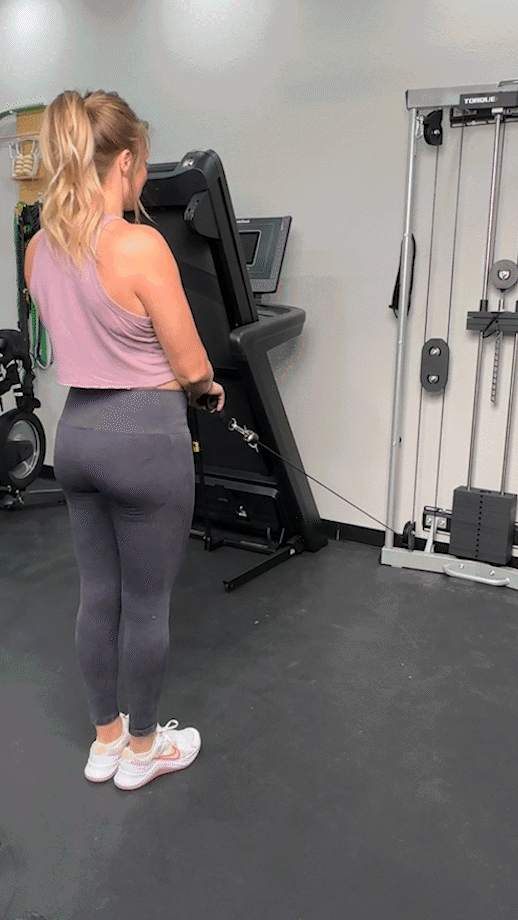
Cable Standing Calf Raise
Why we love it: Activation of the calf muscles is just as important as hitting the other lower body muscles, and there’s no better way to do this than with cable standing calf raises. Try single-leg cable calf raises if you find the below version too easy!
How to do it:
- Find a piece of equipment to lift you off the ground and place it in front of the cable machine. A stepper, box, or weight plate works well here.
- Fix a straight bar to a low cable pulley, and pick your desired weight.
- Grab the bar and step on the equipment to elevate yourself, with only your toes touching it.
- Drop your heels as close to the ground as possible, then push up with your toes to work the calves. Hold, before returning your heels back down.
- Continue for the desired number of repetitions.
RELATED: Calf Exercises
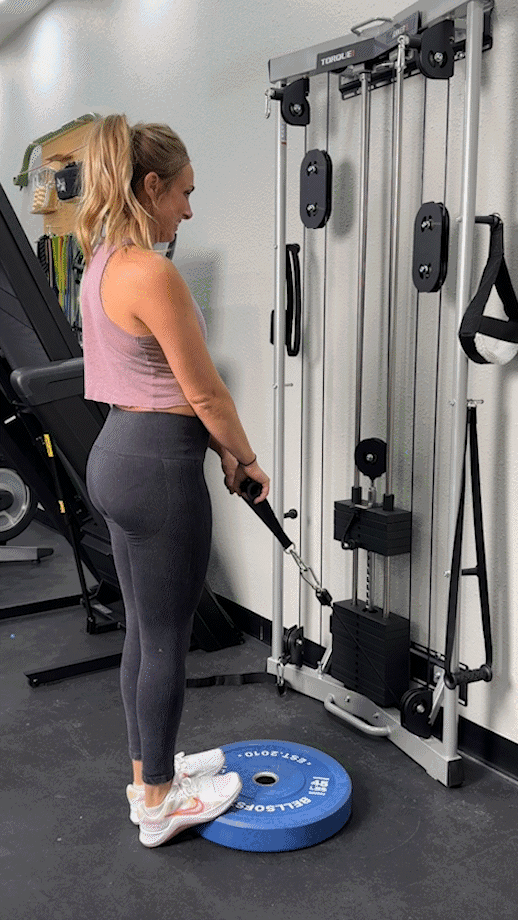
Sample Cable Leg Workout
Okay. You know how to do the best cable leg exercises, but you’re wondering, “How do I make these into a cable leg workout?” Below are three workouts designed by myself and Kate Meier CPT, USAW-L1, CF-L1, and GGR Head of Content:
Beginner
- Cable Goblet Squat: 4 sets of 8 reps
- Cable Standing Leg Curl: 3 sets of 10 reps
- Cable Standing Calf Raise: 3 sets of 12 reps
Intermediate
- Cable Goblet Squat: 4 sets of 8 reps
- Cable Pull-Through: 4 sets of 10 reps
- Cable Hip Adduction: 2 sets of 10 reps
- Cable Hip Abduction: 2 sets of 10 reps
- Cable Standing Calf Raise: 3 sets of 12 reps
Advanced
- Cable Goblet Squat: 4 sets of 8 reps
- Cable Deadlift: 3 sets of 8 reps
- Cable Front Lunge: 3 sets of 8 reps
- Cable Kickback: 3 sets of 10 reps
- Cable Hip Adduction: 2 sets of 10 reps
- Cable Hip Abduction: 2 sets of 10 reps
- Cable Standing Calf Raise: 4 sets of 12 reps
Cable Leg Workout: Final Thoughts
Doing a cable leg workout can give you a more efficient and safer workout compared to using dumbbells and barbells. This is even more the case if you’re new to training or have had injuries in the past, because it can be difficult to get your form right on compound lifts.
To review, here are our nine favorite cable leg workouts for you to try:
- Cable Goblet Squat
- Cable Pull-Through
- Cable Kickback
- Cable Deadlift
- Cable Hip Adduction
- Cable Hip Abduction
- Cable Standing Leg Curl
- Cable Front Lunge
- Cable Standing Calf Raise
Cable Leg Workout: FAQs
Are cable squats effective?
Yes, cable squats can be very effective and are worth considering for your lower-body workout. Kate Meier, CPT, USAW-L1, CF-L1, says, “They’re safer than doing squats with free weights such as barbells or dumbbells.” The other benefit of doing squats on the cables is that it encourages you to get a full range of motion, giving you the most possible work for every rep.
Do cables build more muscle?
According to the Journal of Strength and Conditioning Research8, when comparing cable machines to selectorized weight training machines, the cables give you a greater range of motion (ROM) and better joint angles. This could mean more muscle growth. During cable exercises, there’s constant tension on the muscles, regardless of whether it’s a leg muscle or an upper body muscle.
Can you do leg press with a cable machine?
Unfortunately, it’s not possible to do a full leg press workout with a cable machine. You might be able to get away with the single-leg version, but it will look and feel awkward. There’s no need to worry because there are leg press alternatives that you can do. For example, cable goblet squats and cable front lunges work the same muscle groups as a leg press.
References
- Attum B, Varacallo M. Anatomy, Bony Pelvis and Lower Limb: Thigh Muscles. [Updated 2022 Dec 17]. In: StatPearls [Internet]. Treasure Island (FL): StatPearls Publishing; 2023 Jan-. Available from: https://www.ncbi.nlm.nih.gov/books/NBK482445/
- Rodgers CD, Raja A. Anatomy, Bony Pelvis and Lower Limb, Hamstring Muscle. [Updated 2023 Apr 1]. In: StatPearls [Internet]. Treasure Island (FL): StatPearls Publishing; 2023 Jan-. Available from: https://www.ncbi.nlm.nih.gov/books/NBK546688/
- Elzanie A, Borger J. Anatomy, Bony Pelvis and Lower Limb, Gluteus Maximus Muscle. [Updated 2023 Apr 1]. In: StatPearls [Internet]. Treasure Island (FL): StatPearls Publishing; 2023 Jan-. Available from: https://www.ncbi.nlm.nih.gov/books/NBK538193/
- Binstead JT, Munjal A, Varacallo M. Anatomy, Bony Pelvis and Lower Limb: Calf. [Updated 2023 May 23]. In: StatPearls [Internet]. Treasure Island (FL): StatPearls Publishing; 2023 Jan-. Available from: https://www.ncbi.nlm.nih.gov/books/NBK459362/
- Sadler S, Cassidy S, Peterson B, Spink M, Chuter V. Gluteus medius muscle function in people with and without low back pain: a systematic review. BMC Musculoskelet Disord. 2019 Oct 22;20(1):463. doi: 10.1186/s12891-019-2833-4. PMID: 31638962; PMCID: PMC6805550.
- Whittaker JL, Small C, Maffey L, Emery CA. Risk factors for groin injury in sport: an updated systematic review. Br J Sports Med. 2015 Jun;49(12):803-9. doi: 10.1136/bjsports-2014-094287. Epub 2015 Apr 1. PMID: 25833903.
- Thomas DT, R S, Prabhakar AJ, Dineshbhai PV, Eapen C. Hip abductor strengthening in patients diagnosed with knee osteoarthritis – a systematic review and meta-analysis. BMC Musculoskelet Disord. 2022 Jun 29;23(1):622. doi: 10.1186/s12891-022-05557-6. PMID: 35768802; PMCID: PMC9241212.
- Signorile JF, Rendos NK, Heredia Vargas HH, Alipio TC, Regis RC, Eltoukhy MM, Nargund RS, Romero MA. Differences in Muscle Activation and Kinematics Between Cable-Based and Selectorized Weight Training. J Strength Cond Res. 2017 Feb;31(2):313-322. doi: 10.1519/JSC.0000000000001493. PMID: 28129277.


